Tomica
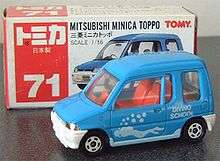
Tomica (トミカ) is the line of die-cast toy vehicles and related products produced by Takara Tomy Co. of Japan (formerly known as Tomiyama and Tomy Kogyo Incorporated) since 1970 (Rixon 2005, 99). Originally these vehicles seem to have been a by-product of Tomica World, a separate line of motorized trains, vehicles and accessories that Tomy produced since 1959. Tomica World motorized trains and track systems, are based on Plarail (About Tomica 2013). Tomica could be referred to as the Matchbox Toys of Japan, and focuses mainly, but not exclusively, on Japanese brands.
History
Tomy Co. of Japan was founded in 1924 by Eijira Tomiyama in Tokyo (Robinson 2010). The company has produced a variety of toys, but in 1970 it started to produce the Tomica line of diecast vehicles as a result of the surge of interest in the global market in toy cars mainly led by Matchbox and Mattel's Hot Wheels (About Tomica 2013). Although models of various scales have been made, the name “Tomica” normally refers to the 3-inch sized mainstream vehicles that are the most commonly sold. Originally Tomica "Pocket Cars" were sold in the 1970s in the USA. After four decades, Tomy Corporation again entered the North American and European markets in 2010 with the Tomica name.
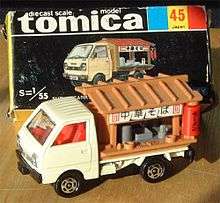
Typical Tomicas
Tomica Domestic Series (“Black Box” / “Red & White Box”)
Initially, Tomica only produced Japanese cars and trucks. This started with the release of six models in 1970. The seventh was issued later in the year. From then on, the Tomica line grew until there was a total of 109 concurrent models by 1978 — nos. 1 – 108 and no. 110 since the no. 109 was proposed and seen in catalogs but never released. The variety of models also expanded from the initial coupes and saloons to taxis, buses, trucks, construction and other commercial vehicles. Even a steam engine and an ocean liner were offered. As new models were issued, each was assigned a number from 1 to 110, thus replacing an existing model.
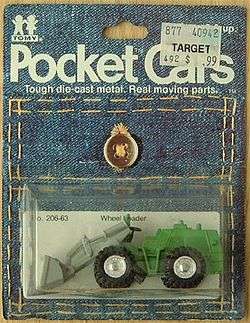
In the early 1980s, Tomy experienced financial difficulties. Subsequently, the domestic model line was reduced to only 80 models (nos. 1 – 80) in 1983. These models were mainly packaged in picture boxes. At first, the boxes used a black background. Since 1984, each new model came with a new style box with a red-and-white background (Rixon 2005, 99). Existing models issued before 1984 kept using the older style box with black background until 1988, when all boxes were updated to the new style. Hence, domestic models are commonly referred to as the “black box” or “red-and-white Box” models depending on their boxes.
Tomica Foreign Series (“Blue & White Box” / "Pocket Cars")
To compete in the global toy car market, Tomy early on, had plans of exporting its models. This was done starting in 1974 with the appearance of “Tomy Pocket Cars” in Canada and the United States of America. The marketing ploy was a blister package designed like a denim jeans 'pocket' with yellow 'stitching' around the outside of the card and the vehicle. Since Japanese cars were not yet booming sellers overseas, in 1976 Tomy started producing 'foreign' (non-Japanese) models. Present were American, German, Italian, British, and French cars, among others, making the Tomica product line more global.
Partly because Pocket Cars were more expensive than Hot Wheels or Matchboxes in the American market, this blister pack series was not seen much after 1979 (Johnson 1998, 233). Tomica continued successfully, however, in the home market, where each foreign car was packaged in a picture box that showed a flag of the country of origin of that particular car. Since these boxes have the base colors of blue and white, they are also called the “blue-and-white box” models. At any one time, a total of 70 models were produced under the foreign line, numbered F1 to F70.
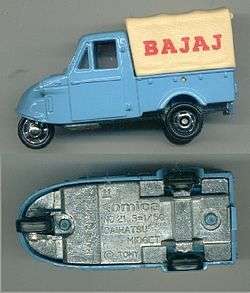
Marketing approaches used by Tomica have thus been curious in several ways. In the American market the company tried to sell unfamiliar Japanese brand vehicles and did not introduce American vehicles in their Pocket Cars line until 1977. American children were generally unfamiliar with these Japanese vehicles. In Japan, as well, the Tomica model selection often seemed odd compared to American and European toy producers. In America and Europe, companies like Hot Wheels (and now Matchbox, too) generally sold the sports, racing or other colorful models that they hoped little hands would reach for. Tomica seemed to produce many more variations of buses, construction vehicles and normal every day car brands. An examination of the list of offerings below shows models that would not normally be seen in miniature in the U.S. market. How often are models of plain Chevrolet Cruzes or Ford Escorts produced as toys? The reason for this sort of out-Matchboxing the traditional Matchbox is perhaps because there have been more promotional deals with real car manufacturers in Japan, so Tomica doesn't see a need to pander to the children's market in more imaginative ways. Probably the closest equivalent producer in the western hemisphere might be the German Siku which has a similar array of all kinds of vehicles - not decked out in flashy colors and fantastic styles.
These cars from the 1970s and 1980s hold their value well. Often they sell for between $15 and $20 US on eBay and other on-line sales sites. Perhaps because of their greater scarcity as well as realism, these values hold up much better than most Matchbox vehicles from the same time period.
Tomica Common Series (“Red-and-White Box”)
.jpg)
In 1988, Tomy combined its foreign models into the domestic series. Most of the first 40 models from the foreign series were added to the 80 domestic models. Those foreign models that got transferred were assigned a number that was its F series number plus 80. A handful of these foreign models were discontinued after a few months’ appearance under the new line. Overall about half of them had been discontinued after two years.
Tomica Limited Series
From 2001 to 2013, Tomy produced the TL series targeted for the collector. These models are made with higher details, and one of their biggest features is realistic-looking wheels with rubberized plastic tyres. Although many of them are based on existing or discontinued regular Tomica models, some are new castings made exclusively for the TL line, namely, Nissan Skyline GTB, Toyoda AA, and new MINI Cooper. In the case of the new MINI Cooper, the model was first released for the TL series in 2004 but in 2006 included in the regular line as no. 43. Model numbers started at 0001. Each model is produced for a limited period of time, so models with smaller numbers are discontinued while new models with higher numbers continue to appear. These models are packaged in open cardboard boxes surrounded on four sides with a transparent plastic sleeve.
Special and Promo Models
Tomica has produced a number of special models over the years. These are unique models that are not found in the regular line or the Limited Series. There are four types of special model:
- An existing regular model with small modifications or additions of accessories. These are commonplace for gift sets. An example is the Mitsubishi Pajero RV found in the 1995 RV 1 Set.
- A truck model that shares the cab and the chassis of an existing model. These are also common for gift sets although also found as stand-alone models.
- A model that is based on an existing model but has the major car body modified. Examples are:
- Honda S800M Convertible modified from no. 23 Honda S800M
- Mitsubishi Pajero Rally Type was modified from no. 30 Mitsubishi Pajero Metal Top. This model was produced for the Ralliart Team Set.
- Toyota Sprinter Trueno AE-86 Hatchback, modified from no. 78 Toyota Sprinter Trueno Coupe. This was produced for the Initial D Set.
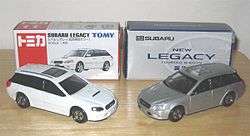
- A totally new casting. All of these had been produced under the contract of another model company or another business. Their common fate is that Tomy eventually issues them as regular models. Examples include:
- Nissan Skyline GT-R R33 Racing Type (issued as no. 40 in 1997)
- Mitsubishi Lancer Evolution IV (issued as no. 104 in 2000)
- Mitsubishi New Canter Panel Truck (issued as no. 29 in 2003)
- Subaru Legacy Touring Wagon (issued as no. 11 in 2003)
- Hummer H2 (issued as no. 15 in 2007)
- Nissan Laurel (issued as no. LV-52 in 2007)
- Isuzu Giga (issued as no. 76 in 2007)
- Also, in 2004, no. 121 was available for a limited period from Mitsuoka Motors. This was a 1/1 scale electric single seater vehicle which featured a retro Citroen H Van front end and side panels.
Hong Kong, China and Vietnam Castings
Until 1993, Tomica models were almost exclusively produced in Tomy's local factory in Tokyo, Japan. One exception was that six of the models issued in 1971 and 1972 were made in Hong Kong:
- 1971 - No.10 Honda N360
- 1971 - No.11 Toyota Sprinter
- 1971 - No.12 Mazda Capella Rotary Coupe
- 1972 - No.30 Mitsubishi Galant
- 1972 - No.33 Nissan Cedric
- 1972 - No.42 Datsun 1300 Pick-Up
Another exception was that a few existing models had their production moved to China in 1990, like the no. 35 DOME Toyota Celica. These were the first made-in-China Tomica models, and are considered quite rare and highly sought after by collectors. All newly issued models, however, were still produced in Japan.
In 1993, Tomy Company of UK contracted Tomy of Japan to produce a line of 36 Tomica cars (the 'British Line') using existing tooling. To save on production costs, these were produced in China. After 1994, Tomy used the China facility to produce new models, and in May 1995, the production of many regular models was moved from Japan to China. This was done in phases and by July 1997, all regular line Tomica cars were made in China. Old castings not used for mass production of the British line, regular models, or gift sets remained in Japan. Special releases and promotional issues using these older castings were thus still made in Japan. There were a few exceptions, for different reasons:
- No. 9 Komatsu Power Shovel PC200, issued in 1995, was made in Japan because the model was already planned in 1994 and also because it shared components with the older no. 9. Production was moved to China when the model was produced for a gift set later in 1995.
- No. 20 Nissan Skyline GT-R R33, issued in 1995, was made in Japan because the model was also used for special releases under the contract of II ADO, a popular chain of minicar shops in Japan. Production was moved to China in 1997 along with others during the last phase of moving.
- No. 30 Mitsubishi Pajero, issued in 1999, was made in Japan because the model was concurrently issued as a special promotional model for Mitsubishi Motors in Japan. Production moved to China after two months, when the promotion stopped.
- No. 105 Coca Cola Route Truck, issued in 1996, was made in Japan as well. However, this model was simply a different colour and livery on an existing casting, so it was not truly a new model.
Production of Tomicas started to move to Vietnam in 2009. At about this time a new attempt to enter the American market was made with Tomica Hypercity, which introduced a limited number of vehicles (about 15) together with varied toy train sets and Lego-like Tomikid figures that are not in scale with the vehicles.
Wheel styles
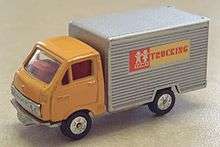
The earliest Tomica cars had one-piece chrome-plated wheels. Starting in 1971, models were produced with two-piece wheels of various styles, with the one-piece chrome-plated wheels being phased out in 1972 (except that all the models made in Hong Kong had the one-piece wheel design). The two-piece wheels were used until 1977, while newer one-piece wheels of various styles have been adopted since 1976, and are still used today.
The most common design is a five-spoke chrome on black plastic form that appears to have five 'slots' around the edge of the wheel. This design has even been continued with the newer vehicles made in Vietnam. Another common style is a black plastic wheel with a single chrome ring and no other outstanding detail.

Other Series
Long Tomica
Lengthier buses and semi-trailer trucks were models not suitable for the regular small boxes, so Tomy also started the "Long Tomica" series in 1977. Castings such as trucks, double-decker buses or Shinkansen trains were produced as single models until 1993. However, some of these long models can still be found in gift sets, such as the JAL Airport Vehicles Set. Many of these were specifically for foreign markets, like the Trathen's Skyliner bus which made the Plymouth to London trek in the U.K. (Rixon 2005, 102).
Combat Tomica
Earlier, Tomy produced the 1/87 diecast Combat Tomica series. The line started with the model M-60 U.S. Army Medium Tank, and later on, models such as the U.S. M-60A-1E-1, the German TIGER-I, the Japanese Type 61 and the Russian SU-85 were produced. There were two types of Combat Tomica but they both contained exactly the same models. The first one was like regular Tomica models; the models came in a paper box, there were some soldier figures for decoration and a set of wheels because the tracks were fixed and did not actually function. The second type was the metal model kits that required manual assembly. These came in larger boxes inside containing the parts for assembly. Production of the Combat Tomicas lasted only a few years, however Tomy continued producing military vehicles such as rocket launcher trucks, troop trucks, and jeeps, for its regular "3-inch" line-up.
Tomica Dandy
Tomica Dandy cars are larger - about 1:43 scale. These were produced from 1972 until 1993, and were at first all Japanese domestic models. Similar to the common Tomica series, the Dandy line also began to offer foreign brand vehicles in 1977 (for example, a Lotus Europa). The numbering system was changed in 1984 based on the nature of the vehicles (e.g. emergency, police, or foreign models). In 2001, Tomy reissued six Tomica Dandy models in limited quantities.
Dandys were diecast metal and also had metal bases. Wheels looked authentic, but were hard black plastic and not rubber, which was normal for such diecast manufacture in the 1980s. Some of these cars had special features like the Mazda Savanna with "pop-up" headlights operated from a lever inside the car (Gardiner and O'Neill 1996, 77). Packaging colors varied and some were promotional models, but commonly, boxes were blue or red showing a perforated license plate shape with 'Dandy' written on the plate. Tomica Dandy castings have also been used in gift sets and the Limited S Series, but these models have the “Dandy” name on their base plates removed.
Motorized Tomica
Tomy started producing motorized cars in 1980s beginning with the Power Tomica series. This series did not last long. In 1992, it released a new series called B/O Tomica (stands for battery-operated Tomica). They were produced and sold as single models until 2003. All the B/O Tomica are made in Japan, while all the Motor Tomica (including the Animated Motor Tomica) are made in China. To fit on the motorized base, these castings often have altered scales. In general, sport utility vehicles appear in their proper scales, saloons appear a bit bulky, and buses and lorries are disproportionately short. In 2005, a new series for motorized Tomica was released containing generic vehicles such as a police patrol car. This late series targets toddlers and is made of ABS plastic.
Pullback Tomica
These first appeared in the 1980s and there were six models at that time. In the year 2002, Tomy again produced pullback models
Tomica Limited Vintage
Starting from 2004, Tomytec, a branch of Tomy, started producing realistic models - more for the collector market. They are marketed as the Tomica Limited Vintage Tomytec series and are mostly 1950s and 1960s classic Japanese vehicles such as the Honda S800, Nissan Cedric, Prince Gloria and Toyopet Crown. More details are evident on these compared to the regular Tomica models or even the Tomica Limited models.
In 2006 the Tomica Limited Vintage - Neo [TLV-N] line was created and currently includes vehicles from the 1970s and 1980s. As with the Limited Vintage series, the focus of the Limited Vintage - Neo series is on adult collectors. These models have a high level of realism, with more attention to details such as wheels, tires, paint, trim and emblems versus functions like opening parts or moving features but still has the suspension of the basic Tomica models. All the models are a consistent scale of 1/64 (Tomica Fan Club).
The Tomica Limited Vintage Neo line focuses mostly on cars manufactured in the late 1970s and onwards, but movie and TV drama vehicles and special race cars have also been introduced.
In 2013, the TLV-N line started featuring the vehicles from TV Asahi's well known police drama series Seibu Keisatsu. The models released for this lineup are either the cars prominently featured in the show, or certain vehicles that end up getting destroyed during the course of the show. Future releases for this lineup will include a 1/64 replica of a TU-89 Ladybird; an armored military vehicle that was the first bad guy vehicle that Daimon Force faced (in the very first episode of the show). The models for this lineup are licensed by Nissan as well as Ishihara Promotion.
Special Character Cars
In the 1970s, Tomica had a special line of models with figures of characters from the cartoon Snoopy sitting on or in the vehicles. Tomica later also produced models with Disney characters on them and also started an utterly new series called Putica for these Disney characters. Circa 1990s, when Tomy created a cartoon called "Tomica Rescue", it started another series using regular Tomica models and some Matchbox models with some add-ons such as cannons, armors and water hoses. In 1996, a series specially designed for the Japanese comic or cartoon "Bakuso Kyodai Let's & Go !!" (爆走兄弟レッツ&ゴー) was initiated. Then came the "Ma-ha Go Go Go" ("マッハGoGoGo" aka "Speed Racer" in the West) series in 1998. In 2002 a series called Magnum Rescue was launched and designed very much like today's Hyper Rescue and Hyper Blue Police. Unfortunately, due to safety issues, the Magnum Rescue Police Cruiser was recalled soon after its release.
In 2005, to celebrate the 60th Anniversary of the renowned Thomas and Friends, Tomy started a Thomas the Tank Engine series. Other recent specialized character Tomica series include "Hyper Rescue", "Hyper Blue Police", the Cars (Disney/Pixar animation) series, Pokémon, Ridge Racer, and the Disney Motors series.
Tomica Model List
Audi
Batmobiles
- 1989 Version, Dark Knight version
Bentley
BMW
- 320 coupe, Shiden 77 prototype racer, Z4
Cadillac
Chevrolet
Daihatsu
DeTomaso
- Pantera GTS
FIAT
- X 1/9, 500
Ford
- Model T (coupe and bakery delivery truck), Horse truck, Mustang GT, Focus RS500
Greyhound
- Scenicruiser bus
Hino
Hitachi
- Hitachi EG110R, Hitachi ASTACO, Hitachi ZW220
Honda
- 1300 coupe, Accord, Airwave, Beat, City, Civic, CR-V, CRZ, Element, Elysion, Fit, Freed, Insight, Integra, NSX, Odyssey, Prelude, S800, S2000, stepWGN, TN360, Vamos, N-One
Hummer
Hyundai Motor Company
Isuzu
Jaguar
- XJ-S
Jeep
- Military Jeep, Wrangler
Lamborghini
Lancia
- Stratos Rally
Land Rover
Lexus
- IS 350, IS F CCS-R, IS F-Sport, GS, LFA, LS 400, RC F
Lincoln
Lotus
Mazda
- Atenza (Mazda6), Axela (Mazda3), Bongo, Cosmo, CX-5, Demio (Mazda2), Familia (GLC/323), Luce, MPV, MX-5 (Miata/Roadster), RX500, RX-7, RX-8, Savanna (RX-7)
Mercedes-Benz
Mini
- New Mini (BMW), Cooper
Mitsubishi
- Colt, Delica, Galant, Grandis, HJ58 (Jeep), i, i MiEV, Jeep, Lancer, Lancer Evolution, Minica Toppo, Pajero (Montero), Pajero Junior, Rosa, RVR (Outlander Sport, ASX), Starion, Mirage, Outlander
Mitsubishi Fuso
- Aero Bus, Canter, Container truck, Aero King, Aero Midi, Super Great, Aero Star, Aero Queen
Mitsuoka
Moon Craft
- Moon Craft Special
Morgan
- Plus Eight roadster
Nissan
- Bluebird (7 models), Caball, Cedric, Caravan / NV350, Cherry, Truck, Cima (Infiniti Q, Infiniti M35hL, Infiniti Q70L), Cube, Elgrand (Quest), Fairlady Z (240Z, 260Z, 280Z, 280ZX, 300ZX, 350Z, 370Z), Fuga (Infiniti M, Infiniti Q70), Gloria (Infiniti M), GT-R, Juke (Infiniti ESQ), Laurel, Leaf, March, Note (Versa), Pino, President, Primera (Infiniti G), Pulsar, Serena, Skyline (Infiniti G, Infiniti Q50), Skyline Crossover (Infiniti EX, Infiniti QX50), Skyline GT-R, Silvia (200SX, 240SX), Stagea, Sunny, Wingroad, X-Trail (Rogue)
Oldsmobile
Packard
- 1932 Roadster
Porsche
- 911 Carrera, Boxster, 928 coupe, 930 Turbo, Porsche 959
Renault
Subaru
Suzuki
Toyota
.jpg)
- 2000GT, 86 (Scion FR-S), AE86 (Corolla Levin), Alphard, Avanza Veloz, bB (Scion xB), Camry, Celica, Celsior (Lexus LS), Century, Coaster, Corolla, Corona, Corona Mark II, Crown, Dyna, Estima (Previa), EX7, FJ Cruiser, Geneo forklift, GT86, Harrier (Lexus RX), Hiace, Hilux, Hilux Surf (4Runner), iQ, Ipsum, Land Cruiser (Lexus LX), Mark II, Mark X (Reiz), Mega Cruiser, MP-1, MR-2, Noah, Passo, Prius, Prius α (Prius V), Probox, QuickDelivery, RAV4, Ractis, Soarer (Lexus SC), Spacio, Sprinter, Supra, Townace, Type-A, Vellfire, Vitz (Echo, Yaris), Voxy, WiLL Cypha, WiLL Vi
Tyrrell
- P34 6 wheel F1 car.
Volkswagen
- Volkswagen Beetle Convertible, Volkswagen Polo, Volkswagen Golf Mk1, Volkswagen Transporter (T2), Volkswagen Camper van.
See also
References
About Tomica. 2013. Webpage from Tomy Tomica website (in Japanese).
Chan, Danny C.Y., and Vic Davey. 1997. The Complete World of Tomy Diecast. Hong Kong: Northcord Limited. May.
Gardiner, Gordon and Richard O'Neill. 1996. The Collector's Guide to Toy Cars. London: Salamander Books. ISBN 0-517-15977-5.
Johnson, Dana. 1998. Collector's Guide to Diecast Toys and Scale Models, Second Edition. Padukah, Kentucky: Collector Books. ISBN 1-57432-041-6
Rixon, Peter. 2005. Miller's Collecting Diecast Vehicles. London: Miller's, a division of Mitchell Beasley. ISBN 1-84533-030-7
Robinson, Ken. 2010. Entry for Tomica. Diecast X change website.
External links
- Official Tomica Website
- Official Tomica USA Website
- Tomy Pocket Cars
- Mike’s Diecast Tanks and Armour
- Hello.to/Tomica
- Tomica Forum
- Andrew's Tomica Collection
| Wikimedia Commons has media related to Tomica. |